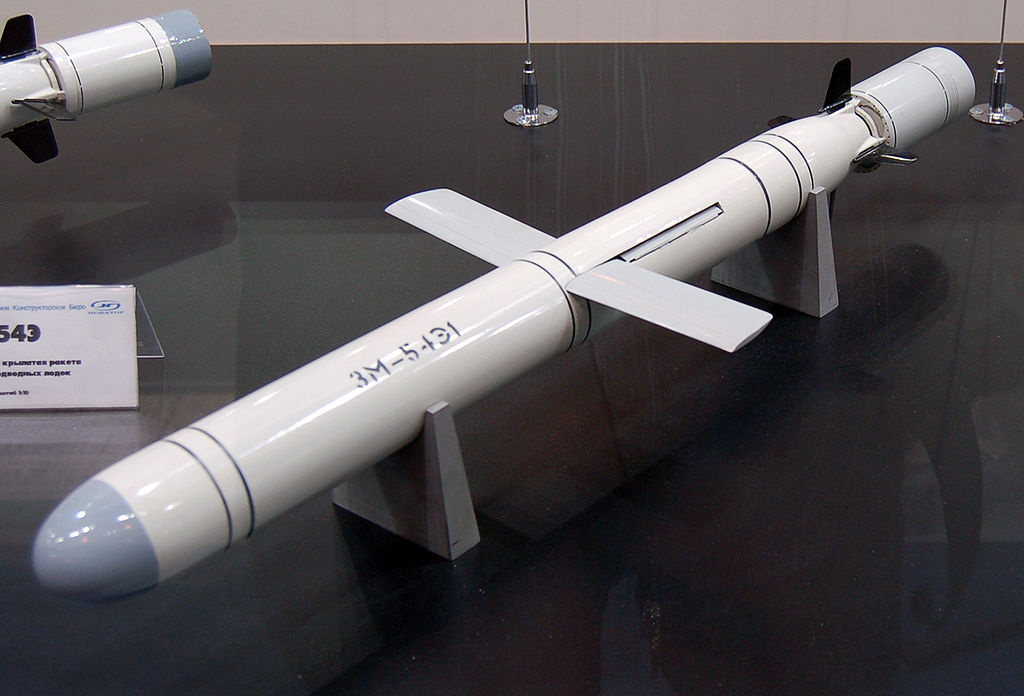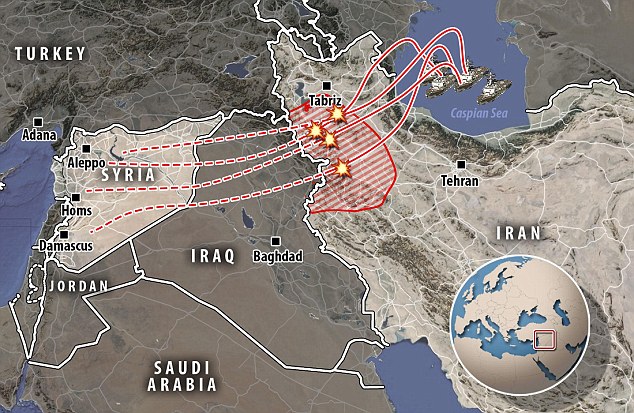
Since the early 1990s, the United States has launched hundreds of Tomahawk cruise missiles from warships and submarines to strike at targets in the Middle East, North Africa, the former Yugoslavia and Afghanistan. Cruising at around 550 miles per hour—roughly the speed of an airliner—Tomahawks can strike targets more than one thousand miles away, making them a popular, though expensive, means of projecting firepower without putting U.S. troops in harm’s way.
However, the United States and the United Kingdom—which also deploys Tomahawks—are no longer the only nations waging long-range cruise-missile warfare.
On October 7, the Russian Gepard-class frigate Dagestan and three small Buyan-class corvettes sailing in the Caspian Sea unleashed a volley of twenty-six Kalibr cruise missiles from their Vertical Launch Systems. The nine-meter long missiles soared nine hundred miles over Iranian and Iraqi territory before slamming into targets into eleven targets in Syria, hitting a mix of ISIS fighters and Free Syrian Army rebels. Although Pentagon sources allege that four of the missiles fell off course and crashed in Iran—inflicting casualties on the Iranian cow population—it was still a demonstration of a long-range strike capability that few countries have used in action.
Following another volley of eighteen Kalibr missiles from the Dagestan task force in November, on December 9, 2015 the improved Kilo-class diesel submarine Rostov-na-Donu launched its own salvo of Kalibr missiles at targets in Syria, marking the combat debut of the modern Russian submarine force. In 2016, Russian frigates in the Mediterranean hammered Aleppo and Idlib with at least three additional cruise-missile volleys.
Russian attack planes were already operating over Syria at the time of the first strike in 2015, and could easily have launched air attacks against those targets at much lower cost. However, by showing off its long-range naval strike capabilities, Moscow not only advertised its technological prowess, but literally advertised the Kalibr missiles capabilities to foreign buyers—who can opt to purchase a shorter-range variant known as the Klub missile.
There are well over a dozen different variants in the Kalibr missile family, varying in launch platform, range, target profile and speed, varying in length from six to nine meters, but all packing a 990-pound warhead or a nuclear payload. The antiship variants—designated the SS-N-27 Sizzler by NATO, or the 3M54T or 3M54K for the ship- and submarine-launched versions respectively—have shorter range, estimated between 270 and 410 miles, and are designed to skim low over the sea to avoid detection. Benefitting from vector-thrust nozzles on the ship-launched versions, the active-radar homing Kalibr missiles are also designed to perform evasive maneuvers instead of making a straight-line approach. As they close within short range of an enemy ship, the missiles accelerate from their cruising speed of Mach 0.8 to Mach 3, and descend to just 4.6 meters in altitudes—making them extremely difficult for a ship’s antimissile defenses to shoot down.
The land attack variants, the 3M14T and 3M14K (NATO designation SS-N-30A), appear to lack the boost to Mach 3 on terminal approach. In compensation, the inertia-guided missiles have a range of between one thousand and 1,500 miles. A third class of Kalibr missiles—the 91RT and 91RE—is used to deploy antisubmarine torpedoes to ranges of around thirty miles.
Kalibr missiles are currently deployed on Russian Navy Kilo-class submarines, as well as more modern types including the Akula, Lada and Yasen classes. They are also deployed on frigates and corvettes—but so far haven’t been fitted on larger vessels, though such upgrades may eventually take place. While a Russian Gepard-class frigate is armed with only eight Kalibr missiles, a missile-armed destroyer would be able to carry dozens.
On the other hand, Russia has demonstrated that it can use numerous small vessels to deploy a powerful long-range weapon, an example of a “distributed” force structure. The idea is that in an age of increasingly lethal and longer-range missiles, it may be wiser to spread out firepower across multiple smaller and expendable platforms, rather than put all the eggs in one large, expensive and vulnerable basket. The U.S. Navy’s own attempts at a more distributed force structure through the Littoral Combat Ship program have so far encountered serious teething issues, and the frigate-sized LCSs currently lack weapons as powerful as the Kalibr missiles on smaller Russian corvettes.
The Klub export variants all have their ranges downgraded to between 140 and 190 miles, so as to comply with the Missile Technology Control Regime, which forbids export of cruise missiles with ranges exceeding three hundred kilometers. Klub missiles are now deployed on Kilo-class submarines in the navies of China, India, Algeria, Vietnam and possibly Iran, as well as India’s six Talwar-class frigates. China also has developed the longer-range YJ-18 cruise missile, which is thought to be a
partial copy of the Klub
أكدت مجلة "المصلحة القومية" أن قدرة روسيا على نصب منصات لإطلاق صواريخ "كاليبر" المجنحة طويلة المدى على سفن صغيرة الحجم تشغل بال العسكريين الأمريكيين.
المجلة الأمريكية كتبت عن هذا السلاح الروسي تقول: منذ بداية تسعينيات القرن الماضي، أطلقت الولايات المتحدة من السفن الحربية والغواصات مئات الصواريخ المجنحة "توماهوك" التي أصابت أهدافها في الشرق الأوسط، وشمال إفريقيا، ويوغسلافيا السابقة وأفغانستان.
سرعة هذه الصواريخ تبلغ نحو 885 كيلومترا في الساعة، وهي مماثلة لسرعة الطائرات، وبمقدورها إصابة أهداف على بعد 1600 كيلو متر.
هذه المواصفات جعلت من هذا الصاروخ، سلاحا غاليا الثمن، لكنه الأكثر شعبية لأنه سمح للولايات المتحدة بالقيام بعمليات عسكرية وتقليص الخسائر إلى أدنى حد ممكن، إلا أنه ليس فقط الولايات المتحدة وبريطانيا تمتلكان صواريخ مجنحة بعيدة المدى!
في السابع من أكتوبر أطلقت السفينة الصاروخية "داغستان" وثلاث سفن صغيرة بواسطة منصات رأسية 24 صاروخ "كاليبر"، واجتازت هذه الصواريخ التي يبلغ طولها 9 أمتار نحو 1500 كيلومتر فوق أراضي العراق وإيران وأصابت 11 مواقعا لتنظيم "داعش" وفصائل مسلحة أخرى في سوريا.
على الرغم من ادعاء البنتاغون بأن 4 صواريخ "كاليبر" سقطت على الأراضي الإيرانية (نفت طهران في حينها ذلك جملة وتفصيلا)، إلا أن استعراض الصواريخ المجنحة الجديدة عمليا تم بنجاح.
في أعقاب إطلاق 18 صاروخ "كاليبر" في نوفمبر من السفينة "داغستان" وقع إطلاق وابل من الصواريخ من غواصة الديزل "روستوف نا دونو"، التي أظهرت إمكانيات الغواصات الروسية الحديثة في إصابة اهداف في سوريا. في عام 2016 وجهت السفن الصاروخية الروسية ثلاث ضربات على الأقل ضد أهداف للإرهابيين في حلب وإدلب.
الطائرات القاذفة الروسية استعملت في سوريا في أولى الضربات عام 2015، وكان بإمكانها القضاء على الأهداف بسهولة، وبثمن أقل بكثير، ومع ذلك اختبار إمكانيات الصواريخ المجنحة الجديدة، لم يمكن موسكو فقط من توجيه الاهتمام إلى انجازاتها التقنية، بل واستعراض فعالية سلاحها أمام شركائها الأجانب الذين يمكنهم اقتناء نسخة صواريخ "كاليبر" التصديرية المسماة " Клаб".
وتوجد عدة نسخ معدلة لمنظومة صواريخ "كاليبر" التي تختلف في نوعية منظومات إطلاقها، ونوعية الهدف والسرعة والمدى، ويمكن أن تحمل عبوات تقليدية أو نووية.
ومدى إطلاق صواريخ "كاليبر" المضادة للسفن (يسميها الناتو SS-N-27 Sizzler) التي تطلق من السفن والغواضات تبلغ ما بين 430 – 700 كيلو متر. هذه الصواريخ لها مسار منخفض فوق سطح البحر، ما يجعل اكتشافها أمرا صعبا.
وصواريخ "كاليبر" المنطلقة من سطح السفن لا تتحرك إلى الهدف في خط مستقيم، بل تناور بمساعدة منظومة ملاحة نشطة، وحين تقترب من السفينة المعادية، تزيد من سرعته بشكل حاد من 0.8 متر إلى 3 أمتار وتحلق على ارتفاع لا يزيد عن 4.6 أمتار فوق سطح البحر، ما يجعلها عصية على المنظومات المعادية المضادة للصواريخ.
الصواريخ المجنحة المخصصة لإصابة أهداف على الأرض نوعي "3M14T - 3M14K " لا يمكنها الاندفاع بسرعة 3 أمتار، لكنها قادرة على اجتياز مسافة من 1600 إلى 2400 كيلو متر. وهناك نسخة معدلة من صواريخ "كاليبر" مخصصة للحرب ضد الغواصات ويمكنها إصابة الهدف على بعد 50 كيلو متر.
أظهرت روسيا أنها قادرة على استخدام أعداد كبيرة من السفن الصغيرة المزودة بالصواريخ المجنحة بعيدة المدى، وهي قوة متحركة. في عصلا الأسلحة الحديثة بعيدة المدى، قرار توزيع القوة النارية على اسطح إطلاق متحركة وعدم الاعتماد على قاعدة كبيرة واحدة مكلفة وقابلة للإصابة يبدو عقلانيا تماما. والبرنامج الأمريكي في الوقت نفسه بتوزيعه المثالي للقوة العسكرية بواسطة استخدام سفن ساحلية يعاني من بعض الصعوبات، علاوة على أن خصائص تسليح السفن الكبيرة في المناطق الساحلية تتخلف عن مواصفات التسليح الروسي لسفن المدفعية صغيرة الحجم.
صحيح أن روسيا تنتج أنواعا مختلفة من الصواريخ المجنحة للاستخدام البحري، إلا أن "كاليبر" تحديدا سيصبح السلاح بعيد المدى الأساسي في السنوات المقبلة. أما الصواريخ المخصصة لإصابة أهداف على الأرض، فمن الناحية النظرية لن تتخلف عن صواريخ "توماهوك" الأمريكية في مواصفاتها، فيما الصواريخ المضادة للسفن القادرة على الانطلاق بسرعة كبيرة تبدو حتى أكثر فعالية.
على الرغم من أن أعداد قطع الأسطول الروسي أقل من الامريكي، إلا أن قدرات روسيا على تزويد السفن صغيرة الحجم بمنصات صواريخ مجنحة بعيدة المدى تجبر العسكريين الأمريكيين على التفكير مليا.
http://nationalinterest.org/blog/the-buzz/why-russias-enemies-fear-the-kalibr-cruise-missile-19129

